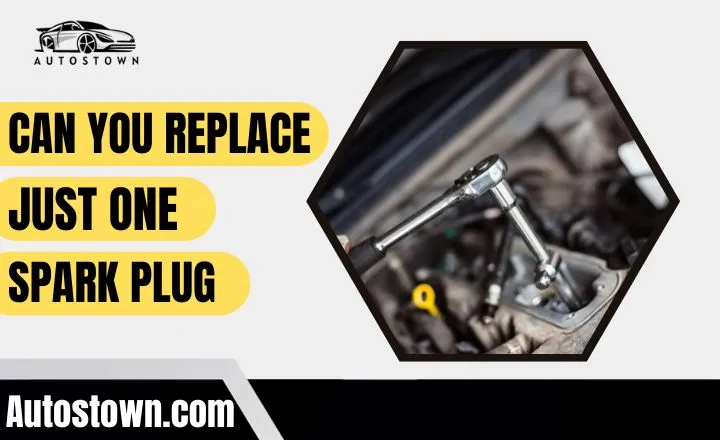Spark plugs are an integral part of any gasoline-powered engine, providing the necessary spark to ignite the fuel and air mixture inside the combustion chamber. Over time, these tiny components can become fouled or worn out, leading to poor engine performance and decreased fuel efficiency. So the question can you replace just one spark plug or replace all of them? The answer is yes – but there are a few key steps you need to follow to ensure your engine runs smoothly and efficiently.
As a car owner, you know the importance of regular maintenance to keep your vehicle running at its best. One key aspect of this routine upkeep is replacing spark plugs when they wear out. But what if only one spark plug needs to be replaced? Can you simply swap out that one plug and leave the rest untouched?
In this article, we’ll walk you through everything you need to know about replacing just one spark plug.
Why does replacing one spark plug matter?
- Because each spark plug is in charge of igniting the air and fuel mixture in its individual cylinder, replacing just one spark plug assures optimum engine performance.
- A malfunctioning or worn-out spark plug can cause misfiring, which reduces performance and efficiency, reduces fuel efficiency, and increases emissions.
- Ignoring one defective spark plug can have a cascading impact on the ignition system as a whole, placing strain on other parts like the distributor cap and rotor.
- By using a process of elimination to determine which particular cylinder is having troubles, you might detect any underlying concerns such as harmed valves or piston rings.
This will also help in understanding:- How To Test A Spark Plug With A Battery.
Tools needed:
Here are the tools you need to replace the spark plug
- Spark plug socket wrench
- Ratchet
- Extension bar
- Socket set
- Gap tool or feeler gauge
- Torque wrench (optional)
- Dielectric grease (optional)
How To Replace a Spark Plug – 5 Steps Guide
Step 1) Find your engine’s spark plugs. Usually located on the top or side of the engine block, they are distinguishable by the large cables that link to them.
Step 2) Begin by replacing one spark plug at a time. Clean off any dirt or debris nearby using the wire brush. When you remove the old spark plug, nothing will fall into the combustion chamber thanks to this.
Step 3) Use your socket wrench to attach the old spark plug to the spark plug socket that you just inserted. To remove it from its housing, give it a counterclockwise turn.
Step 4) Use the gap gauge to measure the new spark plug gap before installing it. If required, adjust it by gently bending the side electrode until the proper measurement is obtained.
Step 5) Hand-install the new spark plug with caution, being careful not to cross-thread it. Use your socket wrench to tighten it further without using too much power after it is snug.
How many spark plugs in V8 engine
V8 engines often have eight cylinders, which means that there are frequently eight spark plugs. There are a few exceptions to this rule, though. For better combustion efficiency and power production, certain high-performance V8 engines, for instance, utilize two spark plugs per cylinder.
Each cylinder may ignite the air-fuel mixture more evenly and burn the gasoline more quickly by using numerous spark plugs. This configuration guarantees that every drop of fuel is efficiently ignited, improving performance and fuel efficiency. Additionally, by providing redundancy—if one plug fails or becomes fouled, the other one can still ignite the mixture—having two spark plugs per cylinder can increase engine dependability.
What do spark plugs do inside the car engine
- The electrical spark that ignites the mixture of air and fuel inside your car’s engine is produced by spark plugs. Your automobile won’t start or function properly without this spark, which is necessary for the combustion process to occur.
- Through their ability to provide feedback to the engine control unit (ECU), spark plugs also contribute to the determination of the ideal air/fuel mixture ratio. This promotes efficient fuel combustion and lowers hazardous pollutants.
- In order to increase durability and performance, modern spark plugs are created with cutting-edge materials like platinum or iridium. These components enable a stronger and more reliable spark, fostering effective combustion and improved operation.
Is it okay to replace one spark plug?
First, it’s advised to replace all the spark plugs if your engine is having problems, such as misfiring or difficulty starting.
Because ignition systems function as a team, changing just one can throw the balance off and lead to future problems. Additionally, spark plugs deteriorate with use and time, so if one is defective, it’s likely that the others will follow soon after.
By changing all the spark plugs at once, you guarantee that each cylinder will operate consistently. More robust and effective plugs are now possible thanks to new technology, which can improve power output and fuel efficiency. You lose out on these advantages and may decrease your vehicle’s overall performance if you merely replace one plug at a time.
Spark plug replacement cost
Spark plug replacement is a duty that frequently goes unattended when it comes to maintaining our cars. However, skipping through this important step could end up costing us later.
Depending on the make and model of your car, replacing a spark plug normally costs between $100 and $300. It’s important to take into account the potential implications of not changing those worn-out plugs, even though this first may appear pricey.
The price to fix a blown spark plug in a Ford F150 varies depending on a number of variables. Between $300 and $500 is the typical cost, parts and labor included.
Conclusions:
In conclusion, you may now have knowledge for answering the question Can You Replace Just One Spark Plug? Replacing just one spark plug is possible as long as the remaining ones are in good condition. This process involves identifying the faulty spark plug, removing it carefully, and installing the new one correctly. It is important to follow the steps outlined in this article to ensure that you do not damage your engine or compromise its performance. Additionally, we recommend that you inspect all of your spark plugs periodically and replace them if necessary to maintain optimal engine functioning. Remember, a little preventative maintenance can save you from costly repairs down the road.
Read More:- What To Spray In a Spark Plug Hole – 5 Steps
FAQ
1. How often should I replace my spark plugs?
Spark plugs should typically be changed every 30,000 to 50,000 miles or as advised by the manufacturer of your vehicle. However, depending on the type of spark plugs and your driving circumstances, exact intervals could change.
2. What are the signs of a faulty spark plug?
Poor fuel economy, slowness when starting the engine, trouble starting the engine, rough idling, and decreased acceleration are typical symptoms of a damaged spark plug.
3. What is the turnaround time for a spark plug replacement?
A single spark plug replacement typically takes 20 to 30 minutes. However, depending on elements like accessibility and previous auto repair experience, this period may change.

